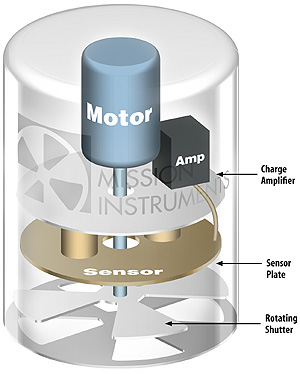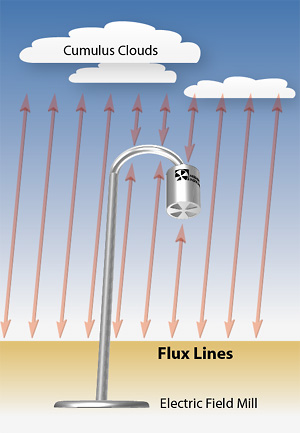| About Electric Field Mill Operation
 Electric Field Mills such as the EFS 1001 and Zebra Field Mill (see Figure 1. EFS 1001 Simplified Diagram) are designed to determine the relative strength of the electric field by comparing the level of the electric field on a known, stable, uncharged reference object. The object used in a field mill is known as the sensor plate. When an uncharged sensor plate is exposed to an electric field it becomes charged. The rate and level of this activity is what the mill is designed to determine. Electric Field Mills such as the EFS 1001 and Zebra Field Mill (see Figure 1. EFS 1001 Simplified Diagram) are designed to determine the relative strength of the electric field by comparing the level of the electric field on a known, stable, uncharged reference object. The object used in a field mill is known as the sensor plate. When an uncharged sensor plate is exposed to an electric field it becomes charged. The rate and level of this activity is what the mill is designed to determine.
 Electric fields are often described and graphically represented as flux lines (see Figure 2. Flux Lines). These lines represent the area in space where the field is present, an area of electrical tension. Any object present within this area of electrical tension will accumulate electric charge at a rate which can be measured. The rate of charge accumulation on this object is a direct measurement of the strength of this electric field. Hence, measurement of this rate yields the electric field strength. The field mill measures this electric charge rate. Electric fields are often described and graphically represented as flux lines (see Figure 2. Flux Lines). These lines represent the area in space where the field is present, an area of electrical tension. Any object present within this area of electrical tension will accumulate electric charge at a rate which can be measured. The rate of charge accumulation on this object is a direct measurement of the strength of this electric field. Hence, measurement of this rate yields the electric field strength. The field mill measures this electric charge rate.
Download This 3-page Document
For Offline Viewing
  Electric Field Mill Operation in .pdf format Electric Field Mill Operation in .pdf format
|
|

Figure 1. Simplified EFS1001 Diagram

Figure 2. Flux Lines
|

